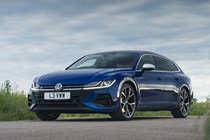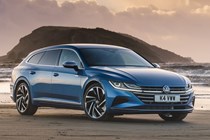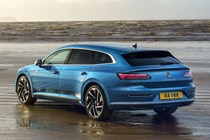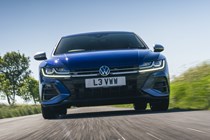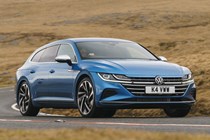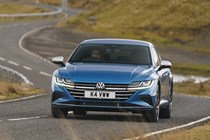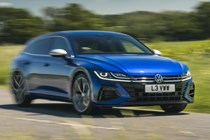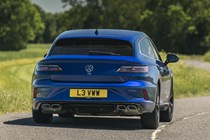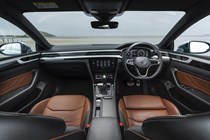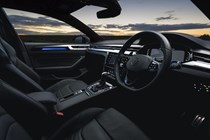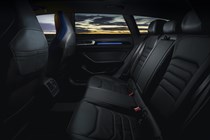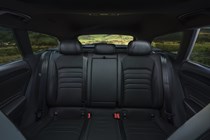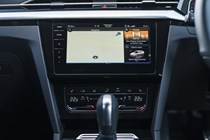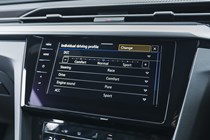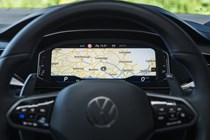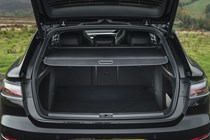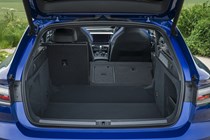
Volkswagen Arteon Shooting Brake (2020-2024) long-term test
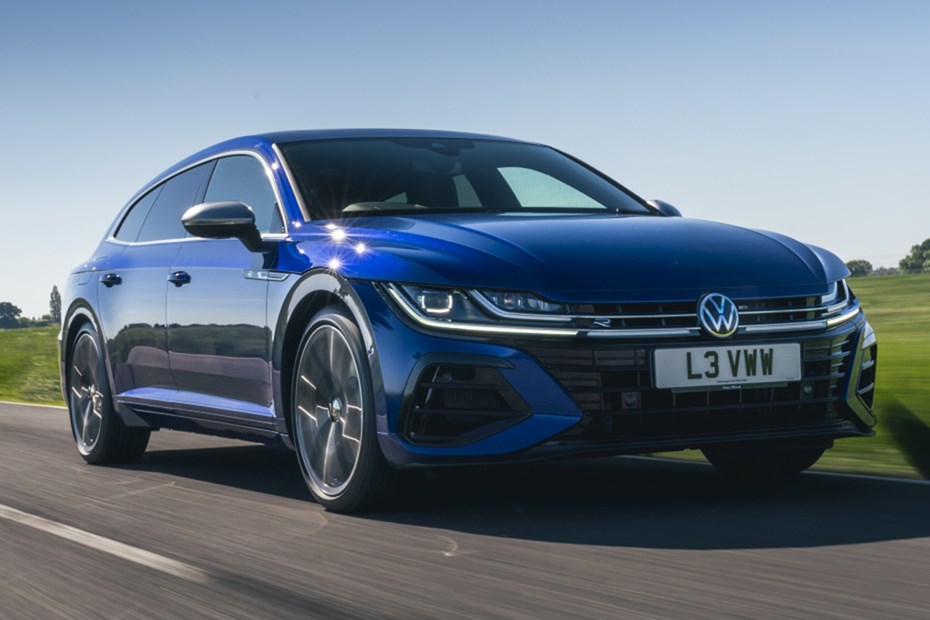
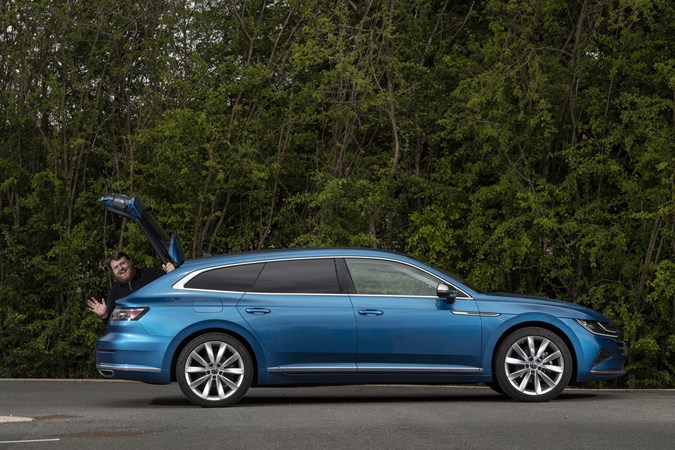
Senior Staff Writer Tom Wiltshire gets his hands on a Volkswagen Arteon Shooting Brake for six months – how’s life panning out with this sexy, swoopy estate as a daily driver?
Scroll down to read the full review or click the links below to jump straight to the report you’re interested in.
Report 2: Do Androids dream of electric that’s cheap?
Report 3: Hey, I put my new shoes on
Report 4: Taking a (Shooting) Brake
Report 5: Motorway miles
Report 1: Welcome
If you want a large family car but you don’t fancy an SUV, your options seem to be reducing by the day. Vauxhall’s Insignia has just been taken off sale, and Ford’s Mondeo died a long time ago – they’re survived by the Grandland and Kuga SUVs instead.
Volkswagen still has you covered, though. Sure, the Tiguan and the Touareg are popular, but you can still buy a Passat in estate form. Or, if you fancy something a bit prettier, there’s what we have here – the Arteon.
The Arteon replaced the Passat CC in 2017 and is available as either a five-door fastback or this Shooting Brake (that’s ‘estate’ in marketing-speak).
In many ways, then, this is Volkswagen’s non-SUV flagship, and it makes a cracking first impression.
I like big boots and I cannot lie
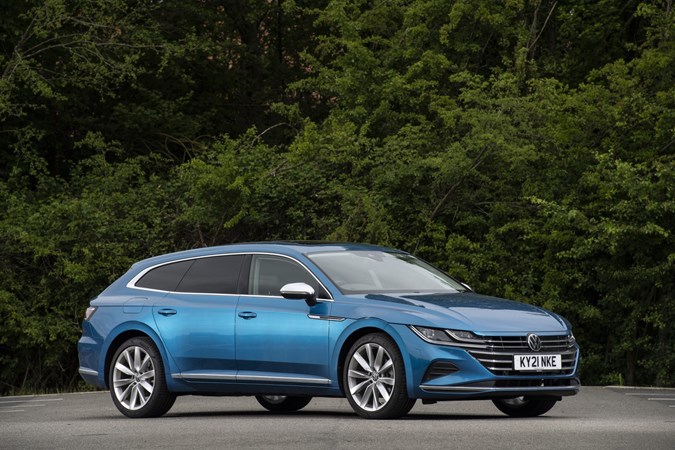
It doesn’t necessarily look like it in photos, but the Arteon Shooting Brake is a BIG car. It’s very long – 4.87m to be precise – making it about as long as a Range Rover Sport. But it’s also low and sleek, and in the metal it looks brilliant, especially in my car’s gorgeous Kingfisher Blue metallic paint.
The real appeal with the Shooting Brake is twofold. First, those looks, which are totally unlike any SUV and convey both prestige and a bit of class. Second, the space. With its long wheelbase, there’s more room in the back seats of an Arteon Shooting Brake than anything this side of a limo – it’s hugely impressive, and means that someone can even sit behind my lanky 6’2 driving position in comfort.
You also get a 455-litre boot, with extra roof height over the hatchback. So far I’ve not even begun to stretch the capacity of this, even when taking my serial overpacker mother on holiday.
Hi, hybrid
Another thing making this Arteon interesting besides its bodacious bustle is the powertrain. This is an Arteon eHybrid, meaning it’s a plug-in hybrid with a 1.4-litre petrol engine paired up to an electric motor and 13kWh battery.
A 1.4-litre petrol may sound weedy when it’s moving along 1,800kg (unladen) of car, but the electrical assistance makes up for any shortfall in power. So far, I’ve never felt as though there wasn’t enough shove in reserve to complete manoeuvres like overtakes or fast sliproads.
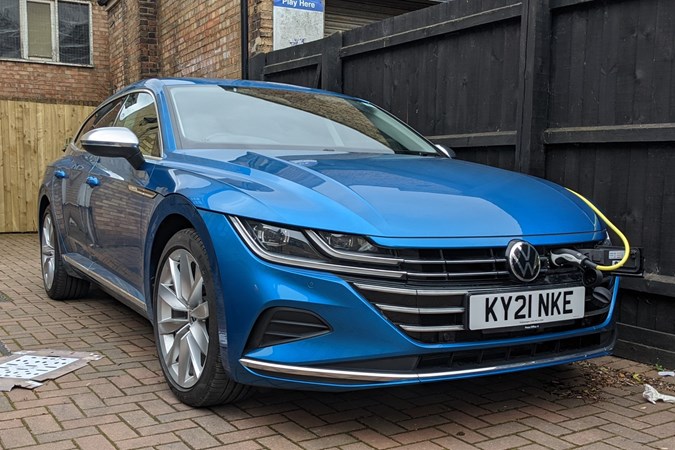
In fact, even when driving on the battery alone, the Arteon’s impressively quick, and I’m certainly happy to do all my local motoring without turning on the petrol at all. Volkswagen says you’ll get 38 miles of range from a fully-charged battery – I’ve been seeing closer to 28, but I’ll keep an eye on it.
One annoyance I’ve found already is the location of the charging port, which is on the front grille. As I’m forced to reverse-park at my house, that means a very awkward route for the cable to follow.
What spec do we have here?
This Arteon Shooting Brake is a particularly nice example, because it’s in ‘Elegance’ spec. Though this is technically the entry-level, it’s not lacking on equipment – what it misses out on compared to the more expensive R-Line is a load of faux-sporting rubbish trim.
It certainly doesn’t lack equipment. Standard fare includes:
- Keyless entry
- Three-zone climate control
- Powered tailgate
- Adaptive cruise control
- All-round parking sensors
- Reversing camera
- LED headlights
- Dynamic chassis control (adaptive suspension
… and plenty more besides.
Our car has a few choice options, though, some of which I’d select if it were my car and some I wouldn’t bother with. The 19-inch ‘Chennai’ alloy wheels look particularly smart, and the adaptive ‘IQ. Light’ LED lights make night driving a breeze. I also adore the wood inserts on the dashboard.
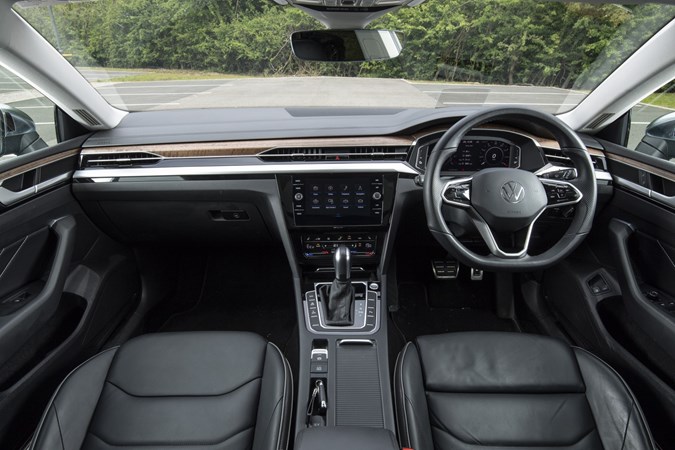
Not sure I’d bother with the upholstery upgrade – while the Nappa leather does feel soft and comfortable, it’s a £1,185 option and the standard seats are just as comfortable. And I tend to shy away from rear tinted glass, though the £1,145 panoramic sunroof is well worth having.
The price? £42,945 before options, and £48,740 after.
I’m really looking forward to getting my teeth stuck into this good-looking estate – my landlord’s very kindly installed a charging point at my home, so I can make full use of the battery and electric motor. What I’m mostly interested in seeing is if this plug-in hybrid can effectively combine the best of both worlds – petrol and electric – for people who only need, want, or can afford one car.
Now, had I taken delivery pre-pandemic, I’d be using the electric section to cover my daily commute and local mileage. But the Parkers team is still working from home, so my journeys are far less predictable. It’ll be a really fun six months with a premium, handsome car finding out what works best.
Fact sheet
- Model: VW Arteon Shooting Brake Elegance e-Hybrid
- Price as tested: £48,740
- Performance: 218hp, 0-62mph in 7.8s, top speed 138mph
- WLTP fuel economy: 243mpg
- WLTP electric range: 38 miles
Report 2: Do Androids dream of electric that’s cheap?
The Arteon Shooting Brake is proving particularly comfy on long trips – but pricier than expected on short ones
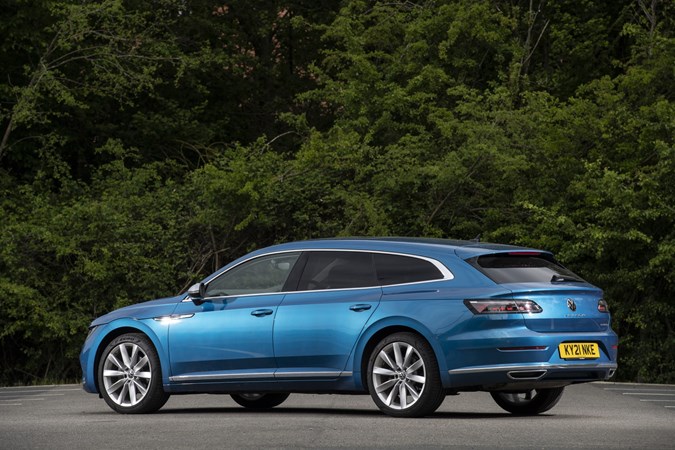
I’m a little while into my custodianship of the Volkswagen Arteon Shooting Brake eHybrid and I have to say, I’m enjoying every minute. This is not an exciting car, nor a dynamic car – but it’s one that tackles everyday journeys with a competence and refinement that really impresses me.
The Arteon’s had a mixture of trips to tackle during its time with me, as I’ve been using it as my daily driver for the most part. That means trips in and around Peterborough, heading to the shops or to see friends. It’s also suffered several journeys into the depths of Norfolk – fast, single-carriageway roads with lots of overtaking and even more potholes.
As well as that, it’s taken on my usual mixture of motorway slogs both North and South. It’s these that are the Arteon’s natural habitat – it’s refined, powerful, and superbly comfortable thanks to good seats and that long wheelbase easily ironing out imperfections in the road.
And relax
Comfort really is the Arteon Shooting Brake’s priority. Though my car sits on massive, 19-inch wheels, it rides superbly. Not always the easiest task – where I live in the Fens, flat roads are an anomaly and depending on which direction I turn out of my house I’m treated either to vast crests and gulleys or tarmac pockmarked enough to trouble a Mars rover.
I can add excellent refinement to its list of talents, too. Though a little tyre roar does invade the cabin, that slippery shape means very little wind noise, and even when the engine’s running there’s not much chatter from under the bonnet. Of course, to make it even more refined, I can just employ the 25 miles or so of electric range.
I have the power
Running on electricity is a lovely experience. The Arteon’s electric motor produces 113hp on its own, which is ample for running around at city speeds. It’ll even propel it smoothly up to a motorway cruise, keeping pace with traffic – though don’t go expecting to beat anybody away from the lights.
The range is plenty for my daily uses, easily covering the 20 miles to and from the office with some in reserve. However, a quick bit of fag-packet maths puts the cost of those electric miles into perspective – it’s not necessarily the money-saving exercise I’d hoped it would be.
At my current electricity rate (29.23p/kWh) a full charge for the Arteon costs me around four pounds – making it just over 15 pence per mile if I average 25 miles to a charge.
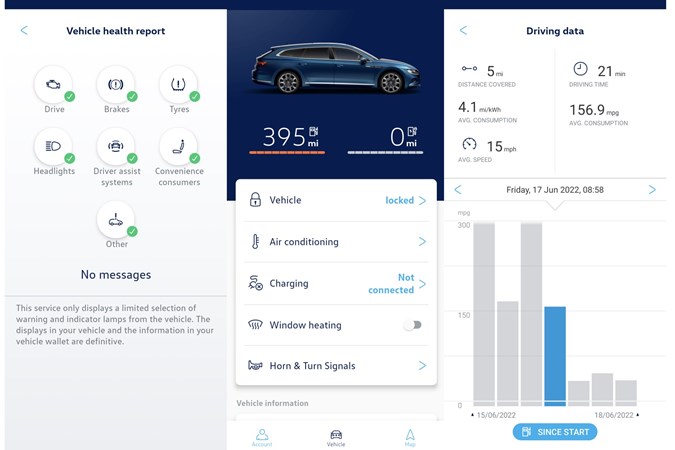
A few weeks ago, before petrol prices went absolutely crazy, that was almost exactly the same cost per mile as running on the engine alone – based on the 48mpg figure I’ve seen with a discharged battery over a fast A-road journey.
With petrol at almost £1.90 a litre, the gap’s widened a bit, but don’t go thinking that just because the Arteon plugs into the wall that the electricity is free. A daily charge could easily add more than £100 a month to your energy bills.
The obvious solution to this would be to switch to one of many tariffs that offers cheap overnight electricity – and if I still worked regularly from the office, I’d do just this. The problem for me and I suspect many others is that I still work from home a majority of the time, and these tariffs spike energy costs during the day – so I wouldn’t save any money.
Phoning it in
A final couple of thoughts for this month concerns my phone. I’ve of course installed the Volkswagen We Connect app – above – and find it useful if a bit slow. Definitely recommended if you have a Volkswagen hybrid, and even more so if you intend to use features like delayed charging or pre-heating.
My phone’s also useful in the car. Like many of my colleagues, I almost exclusively use Android Auto these days – it replaces VW’s interface with one powered by my own smartphone giving access to maps, music and phone calls seamlessly.
VW’s taken the decision to fit wireless Android Auto – which is great – but it hasn’t paired it with a wireless charging pad. So I need to plug my phone in anyway. What’s the point?!
Mileage: 11,700 miles
Average fuel economy: 62.8mpg
Report 3: Hey, I put my new shoes on
A rogue piece of metal takes out one of our VW Arteon Shooting Brake’s tyres in the prime of its life – and replacements aren’t cheap
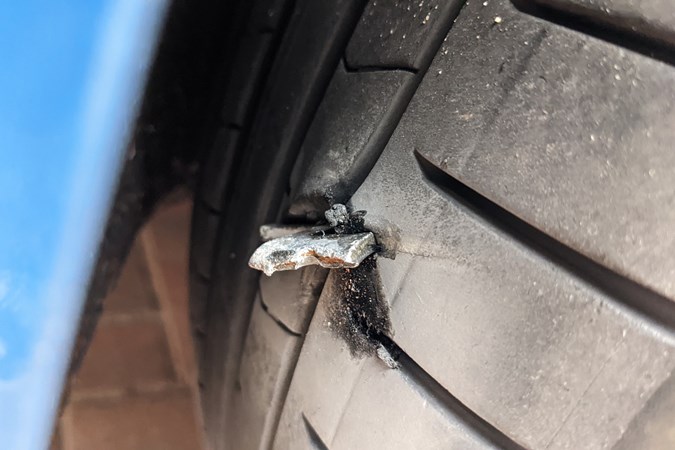
A flat tyre, part-electric seats and optional wood form this month’s musings
I’ve actually never had a flat before. I’ve been in cars that did – one particularly memorable summer in France springs to mind. My dad’s Mazda Bongo, freshly imported from Japan, was riding on rear tyres barely up to the job of suspending the car, let alone eight people and their luggage. One let go in a spectacular bang.
Luckily it let go right outside Monsieur Phil’s tyre shop, and we were soon on our way with new rear boots. One of which let go with a second spectacular bang ten minutes down the road, as it too wasn’t up to the task…
My own recent experience was far less dramatic, though. I heard a small thud, and a repetitive flapping sound, so pulled up the Arteon’s tyre pressure monitoring display on the virtual cockpit. Sure enough, I was losing pressure in the right rear.
I did manage to make it the few miles home, though, which surprised me a few days later when I had the tyre replaced and saw the size of the chunk of metal that had punctured it. I’ve got Pirelli to thank for that – the Arteon’s fitted with ‘Seal Inside’, a layer of mastic that flows into any puncture – kind of an evolution of run-flats. Very useful stuff.
£165 and very little fuss later, I’ve now had a tyre fitted at home. What did we do before mobile tyre fitters became commonplace? Well, I suppose most cars had spares…
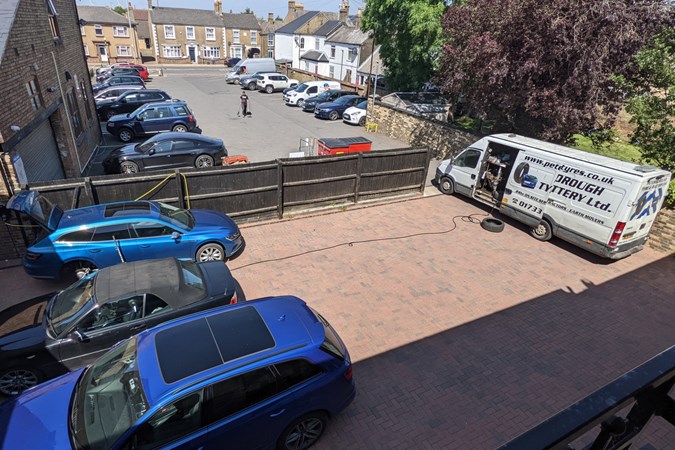
Got wood?
What else has sprung to mind? Well, a carwash attendant asking me how my seat moved forward and back, obviously requiring me to admit with embarrassment that they’re only part-electric. The horror.
It genuinely doesn’t bug me, but I do wonder if it would really have been that much more expensive to just electrify the whole shebang as well as the backrest and lumbar support. I’m a firm convert to electric seats – during time sharing long-termers with shorter colleagues, it’s great having my own driving position ready to call up in an instant.
Luckily there’s one aspect of the interior I can’t fault. Wood trim in an executive car just makes sense, doesn’t it?
Mileage: 12,050 miles
Average fuel economy: 68.0mpg
Report 4: Taking a (Shooting) Brake
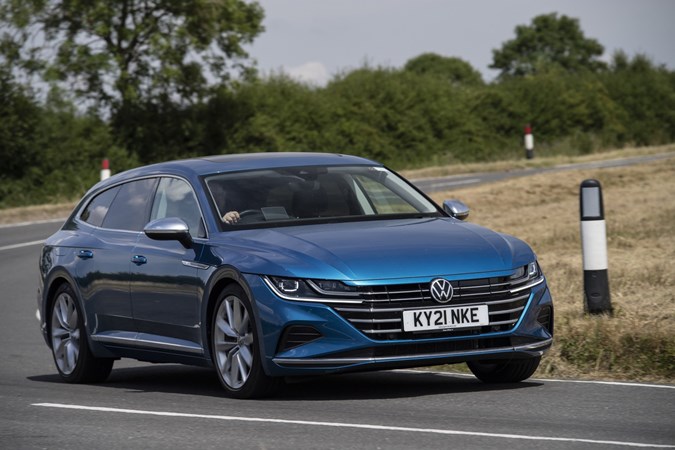
Driving the Volkswagen Arteon Shooting Brake is a pleasure. There, that was easy.
Several months with this car have shown me what it isn’t – it’s not exciting, it’s not vibrant, it’s not particularly expressive – but they’ve also shown me very clearly that it is comfortable, efficient, refined, and very grown-up.
My colleague on our sister site CAR, Jake Groves, noted that this eHybrid model is ‘a rare PHEV in that it’s not obscenely overpowered’, which I think is spot on. The willy-waving between manufacturers to make their plug-in hybrids more and more powerful is largely pointless – these are sensible cars, driven to fulfil company car fleet manager’s CO2 requirements and designed to be best while pootling. The 215hp on offer here is more than enough.
Notably, driven next to rival PHEVs such as those from the Stellantis group, the Arteon feels as though its electric motor is significantly more powerful. It’s not – there’s only a few hp in it – but the VW seems to rely on the motor more and the engine less, making it feel more as though the two power sources are working in harmony.
It’s a great effect and one I’ve grown to really appreciate over many long drives in this car.
GTE bourgeoisie
Now, this Arteon – as all models are – is equipped with adaptive dampers, and eHybrid models also get a ‘GTE’ button which puts everything into Maximum Sporty Attack mode. And I have to say I’m thoroughly pleased with how well this car goes round corners when you ask it to.
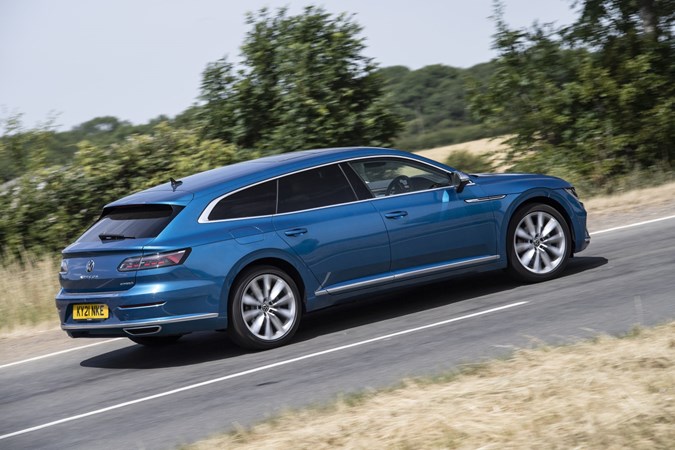
It’s not playful like a hot hatch, but keep your inputs smooth and you can take bends with more speed than is strictly sensible with the minimum of drama. It’s actually rather satisfying to sling a series of curves together, which isn’t something I thought I’d be saying when I was told I’d be running a hybrid Volkswagen estate car for the next few months.
But those few months are up – the Parkers long-term Volkswagen Arteon Shooting Brake’s heading off to a new custodian within the team soon, so this will be my last report on it – the remainder will be taken on by my esteemed colleague Luke Wilkinson. I hope he likes it as much as I do.
Mileage: 12,766 miles
Average fuel economy: 66.2mpg
Report 5: Motorway miles
Luke Wilkinson has taken over from Tom as the Arteon’s caretaker – and he’s spent a lot of time driving it in the past month
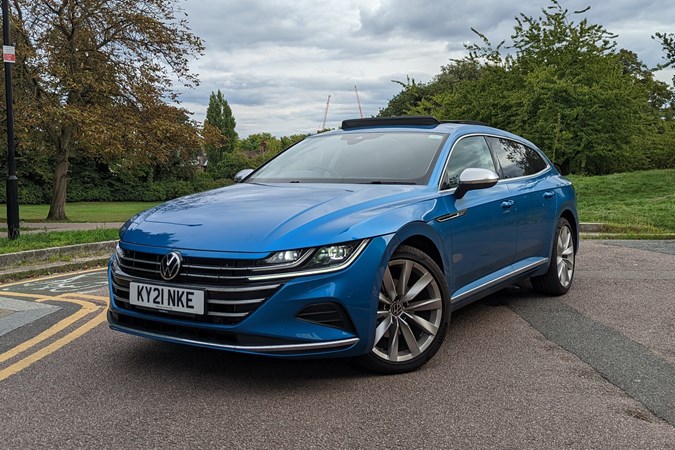
I covered a lot of miles in September 2022. I almost drove twice the length of Britain in outright distance, starting my month off in London before travelling to my parents’ house in Cumbria. After that, I drove to Glasgow and back twice in the same week, then returned to London. Thankfully, all this driving gave me plenty of opportunity to get to grips with my new long-termer.
There are a lot of things the Arteon does well. I’m impressed by its plug-in hybrid powertrain. Drive it gently with a full battery, and it’ll easily average around 60mpg. GTE mode (as Tom touched on above) is a good laugh, too – and I found that the car claws back more battery power when running in this mode by ramping up the brake regen and siphoning power off the engine. It’s clever stuff.
I like how comfortable the Arteon is, too. Its massive wheelbase means it glides over crests and dips – and, providing you keep the adaptive dampers locked in Comfort mode, the suspension is supple enough to shrug off fast potholes and expansion joints.
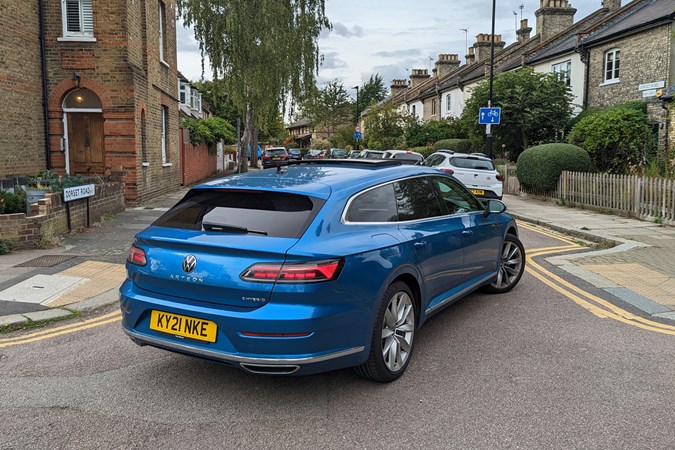
The cabin is a nice place to be as well. It’s quiet, the build quality is good (which it should be for almost £50,000), the front seats are supportive and the driving position is well-judged. I don’t even mind the wood trim, which has been a somewhat contentious issue in the office.
Not all is perfect, though. I’ve already experienced a couple of problems with the Arteon that you’ll also likely encounter if you buy one – especially if you’re shopping used.
Technology troubles
The infotainment system is a mixed bag. I like the way it looks – the graphics are sharp and the menus aren’t too complicated, which means you can use it with reasonable accuracy on the road. I also like the way my phone connects to Android Auto wirelessly, but I agree with Tom that it’s a massive oversight having that technology without a wireless smartphone charger to support it.
I also couldn’t get my phone to pair with the car through Volkswagen’s We Connect app. It seems the Arteon simply can’t come to terms with losing Tom – and it certainly doesn’t want to settle for me. I know I’m making light of the problem here, but this inability to pair new users to the car could prove very troublesome once the Arteon starts hitting the used market in large numbers.
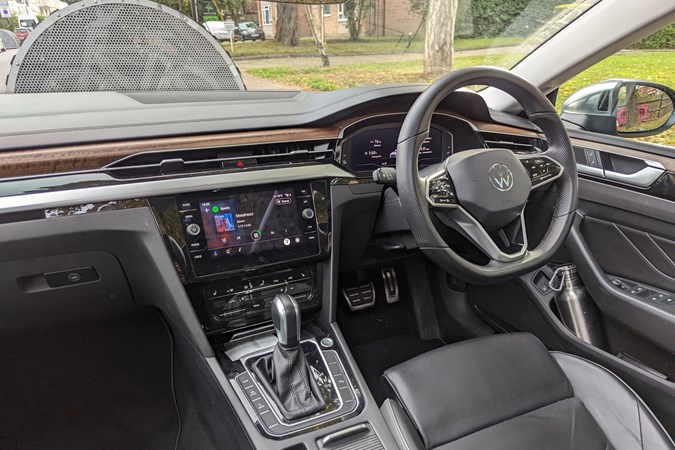
Most importantly, the Arteon’s abandonment issues are making it difficult for me to monitor how much charge its battery pack has. I charge up as often as I can but because there are only a few Type 2 lamppost ports in my corner of London, I try to use them respectfully. Nobody wants to be the inconsiderate pillock who’s unnecessarily hogging an EV charging bay.
The nearest charger to my house is a good 10-minute walk away – and I’ve already wasted days of my life trudging back and forth to the Arteon to manually check the charge progress on its infotainment screen, swearing all the way because there’s a broken app on my phone that should allow me to do the exact same thing from the comfort of my own home. If you’re reading this, Volkswagen, I think a firmware update is long overdue.
Five-up and fatigued
In the past month, I’ve also discovered the Arteon isn’t a very good five-seater, which surprised me considering how enormous the car is. In early September 2022, I was elected as the driver for a family trip abroad. I thought it was a good idea to use the Arteon as the airport shuttle, because its boot was more than big enough to hold everyone’s luggage and there’s loads of space in the back.
I assumed everyone would be comfortable, but I was wrong. Despite its considerable girth, it seems the Arteon’s rear bench was only designed to hold two passengers in comfort. The outer two seats are very wide, while the middle seat is very narrow, which means the passenger sitting in the middle (who was my dad in this instance) will spend their entire journey clamped in a death lock between those either side. That’s a sure-fire recipe for numb legs.

The middle seat isn’t particularly well-shaped, either. There’s no lumbar support so, when my dad prised himself out of the car at the airport, he could barely walk to the terminal. It’s also set very high which means the central occupant towers above the other passengers, blocking the driver’s view out of the rear window. If you’re tall, you’ll be constantly bashing your head into the roof light, too. Look at the difference in headroom between my girlfriend and I in the image above. If you’re carrying three people my size, it’s going to be an uncomfortable experience.
The Arteon’s 19-inch alloy wheels produce one final comfort issue – and it’s not that their tyres are too thin. In fact, the wheels are slightly too wide which, coupled with the car’s broad stance, makes the car tramline on the motorway. They lock into channels worn into the road far too easily, dragging the steering off course and forcing the driver to make lots of corrections.
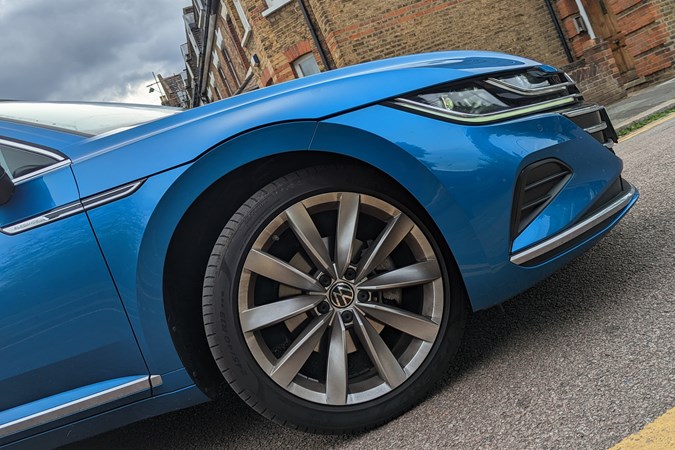
The issue can be alleviated by engaging the lane-keeping assist system, but that can produce its own set of problems. For example, if the road markings aren’t perfect, the Arteon can recognise things like repaired sections of tarmac as lane dividers and push the car out of its lane.
The system also makes it a chore to drive down narrow country lanes, as you’ll be constantly fighting the steering. On rural roads, you often need to clip the white lines to safely check your sightlines, spy for passing places and clock oncoming traffic, especially when you’re assaulting them in the aircraft-carrier-sized Arteon Shooting Brake.
Faux fuel economy figures?
I mentioned above that I try to charge the Arteon regularly. There’s a reason for that – once you empty the battery pack, your fuel economy will evaporate faster than a cheeseboard at a Tory lockdown party. On the motorway, I struggled to get the Arteon into the high 30mpg range once I’d drained its cells, even when I was in it alone.
My colleagues have told me that they’ve managed to extract average fuel economy figures in the low-to-mid-40mpg range, which has baffled me further. Maybe I’ve got a heavier foot? Or maybe it’s because I was asking the Arteon to deal with some of the highest motorways in Britain, which pulled the average down for the trip.
Whatever the reason, I highly suggest keeping the Arteon PHEV’s battery topped up. A steady 60–80mpg in hybrid mode is a small price to pay for the minor inconvenience of connecting a cable.
Mileage: 14,752
Average fuel economy: 41.4mpg



